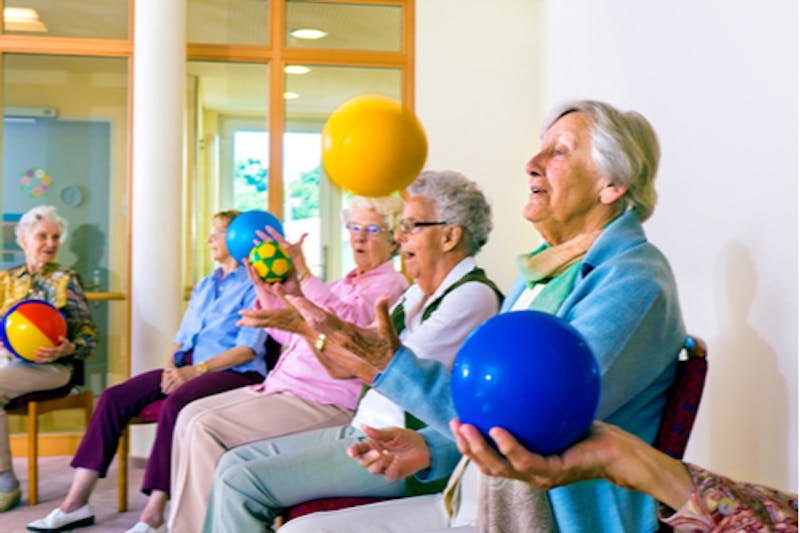Of course, consideration of your loved one’s safety, security and happiness is first and foremost on your touring agenda. But, let’s face it: The substantial cost of living in a senior community weighs heavily in the decision-making process.
Prospective expenses in each community require considerable research and review. It’s important to realize that there are vast inconsistencies in costs associated with similar services across assisted living communities.
It’s easy to be distracted by sophisticated amenities and services like swimming pools and concierge services. Resident fees typically reflect the community’s costs for offering such accommodations, so it’s necessary to dig deeper into understanding costs that are “supplemental” to the base fee.
We’ve assembled this list of common services and amenities to prompt discussions with your loved one to determine which services are necessary versus those that would be “nice to have”. The good news is that most of the amenities and services listed here are fairly common across residential communities, so it won’t be too difficult to find communities that fill specific needs. The critical differences will lie in the associated cost for the services.
When you physically tour local communities that meet your requirements, be sure to ask about specific services and their costs. By identifying your parents needs and gathering detailed cost estimates up-front, you’ll build a better comparison of total costs across the communities you consider.
Let’s get started with a review of the most common services and amenities found in assisted living communities.
1. Assistance with Activities of Daily Living
One of the primary reasons that seniors enter into assisted living is to meet their increasing need for daily help with self-care tasks such as bathing or getting dressed.
Activities of Daily Living (or ADLs) is a term that’s used to describe tasks or skills that adults perform when living safely and independently. Assistance with any of the following ADL tasks can be provided at an assisted living community through supplemental services.
ADL basic self-care tasks are:
- Walking
- Self-Feeding
- Dressing and Grooming
- Toileting
- Bathing
- Transferring
- Shopping and meal preparation
- House cleaning and home maintenance
- Managing transportation (either self-driving or public transportation)
- Managing communication (via telephone or mail)
- Managing medications
- Managing finances
Key Point #1: The most important assisted living services are related to activities of daily living such as bathing, feeding, and taking medicines.
2. Dining & Meal Plans
For assisted living residents, answering the question “What’s for dinner?” is as simple as checking the social calendar. Seniors enjoy their hassle-free (often waited full-service) social dining experience with tasty, nutritional chef-inspired meals, prepared to meet senior needs. What’s more, they’re free of the burden of shopping, cooking and clean-up that goes hand-in-hand with the task of preparing meals!
To assure good resident nutrition, monthly assisted living residential fees include a basic meal plan, which provides daily meals, often served in a cafeteria or dining room setting. Some communities offer creative meal options like grab-and-go breakfasts. Additional services, like in-room meal deliveries are possible, often for a supplemental fee.
Certainly, dietary needs unique to seniors (link to internal Top 10 Senior Nutrition Tips post) are carefully considered and offered to residents. Be sure to check literature, ask specific questions about food services and request to sample meals at communities you tour.
Key Point #2: Meal plans are an important part of assisted living. Ask to be sure they are included in your monthly contract.
3. Housekeeping & Laundry Service
Typically, assisted living residences are small, individual apartments designed for private living. It can be difficult for senior residents to keep up with laundry or maintain a clean and tidy home. Fortunately, optional laundry and housekeeping services are available to residents of assisted living communities.
Light housekeeping such as taking out trash, vacuuming, changing bedding, cleaning the bathroom and kitchenette relieves the residents’ burden of these residential chores. In-house or external service providers are available to wash and dry laundry for residents.
Key Point #3: Assisted living homes provide housekeeping and laundry services, ask if they are included in your monthly contract price.
4. Transportation & Companion Service
Although many in-house services are provided at assisted living communities, there’s often the need for a resident to visit a doctor or dentist off-site. If a family member or friend is unavailable to drive a resident to an appointment, it’s often possible to arrange for transportation to and from the doctor’s office with a qualified companion. Often a one-time “as needed” fee is associated with this service.
Key Point #4: Some assisted living homes provide transportation services for off-site medical appointments - be sure to ask about the cost.
5. Fitness Centers & Pools
Many older adults enjoy the benefits of their physical fitness regime into their senior years, and want to continue their healthy habits after moving into an assisted living community. To support and encourage residents to maintain mobility and better health, many assisted living communities include fitness center amenities with commercial exercise equipment for resistance and cardio training. For seniors who enjoy the benefits of swimming, look for assisted living communities that boast community pools.
Communities with limited space may not include a designated fitness room, but speak to an activity director about planned group fitness sessions like yoga, seated flexibility workouts, group walks and more.
If your parent works with a physical therapist, check that the facility permits and has room to accommodate the convenience of in-house therapy sessions.
It is important seniors exercise as it is one of the best known activities to reduce cognitive decline.
Key point #5: Fitness centers and classes in assisted living homes are great amenities to seek as they greatly help with physical and cognitive functionality.
6. Staying Connected: Cable, Internet & Telephone
It’s important for residents and their families to stay connected to the world beyond their community through cable television, internet and telephone service.
Typically, each private residence in an assisted living community is wired for cable television, internet service and telephone service. Most modern communities offer free WiFi, but in-room cable television and phone services are managed and activated by local utility providers, with separate accounts for each individual residence. Take note if any of these additional services (and associated costs) should be considered.
Key Point #6: Assisted living homes provide cable, internet and telephone services but could in some cases be billed separately to the resident.
7. Medication Management
At least 87% of the population over the age of 65 use prescription drugs, with an average of 20 different prescriptions per year. It’s easy to imagine that it's burdensome for seniors to stay on track of their daily medication schedule. (Not to mention struggling with those “childproof” caps!)
Assisted living communities offer medication management services that’ll ease this burden, by creating a customized medication schedule, and administering medications to residents at scheduled times. They can also re-order prescriptions from the pharmacy when refills are needed.
Key Point #7: Assisted living homes can provide medication management services. It is usually billed separately and can cost a few hundred dollars so read the fine print carefully on this.
8. Spa Services: Hair & Nail Salon / Barbershop
In-house salons help residents look great and feel good about themselves! Most assisted living communities rent an onsite salon room to qualified beauticians who offer personalized service to residents: washing, styling and cutting hair, and manicuring nails. An onsite salon or barbershop is convenient for residents of the community, especially because it eliminates the need to arrange for transportation to an outside shop.
Key Point #8: Assisted living homes often provide salon services which come at an additional cost.
9. Security & Emergency Call Services
Resident security (especially for memory care residents) should be a senior community’s top priority. Assisted living personnel should know the whereabouts of every resident through a carefully-managed check-out / check-in system with doorway monitoring and security cameras.
Resident safety should be top priority for all older adult residential care communities like assisted living, and should be provided to all residents at no additional cost. Every room should be equipped with an emergency call service that’s monitored 24 hours, 7 days a week. State requirements vary, so ask if the community employs 24-hour on-call nursing.
Key Point #9: Assisted living homes provide building security features and emergency call service features which are almost always included in the monthly price.
10. Pet Care
Animal companionship is very beneficial to all pet owners, and seniors are no exception. Some assisted living communities permit small pets in residential apartments. However, a senior pet owner may need occasional assistance with dog walking, grooming, changing kitty litter, or taking their furry friend to the veterinarian.
If pets are permitted at a senior residential community, it’s likely that pet care services are also available, typically through an outside service provider. When inquiring about costs, also ask about the reliability of the service.
Key Point #10: Assisted living homes may allow for cats or small dogs. Ask about any pet fees beforehand.
Top 10 Takeaways: Services & Amenities in Assisted Living Communities
The bottom line: Estimates of assisted living expenses should consider all costs for supplemental services that your loved one requires. In addition, normal utility costs (like phone or cable) and ancillary costs (transportation and pet care) should be considered as part of the “big picture”.
Comparing costs between assisted living communities is NOT straightforward. Communities invoice for services differently, so care planning and budgeting is potentially confusing to sort out. Be sure to have a clear understanding of the specific services and amenities that are included on monthly charges for each community you consider.
Remember that most communities charge additional fees over their base residential rate, and certain fees are not covered by Medicare.
Imagine your disappointment after moving a loved one into a community and learning that the services you assumed were included in the residential rent are not included. Worse, getting blown away by incremental costs you didn't include in the budget!
By researching up-front, you’ll have greater peace of mind with a clear, detailed understanding of your parent’s community monthly billing. You’ll be able to comprehend and adapt to changes in incremental service levels (and associated costs) in the future.
1. Assistance with Activities of Daily Living - Fees are typically on a tiered service schedule.
2. Dining and Meal Plans - Typically included in residential contract, but be sure to ask for details.
3. Housekeeping and Laundry Services - Some housekeeping may be included in the residential contract, but get clarity costs and what services are and aren’t included.
4. Transportation and Companion Services - Typically one-time charges.
5. Fitness Centers and Physical Fitness Classes - May be included in the residential contract or there may be an additional monthly fee.
6. Cable, Internet and Telephone Services - Fees are managed by separate utility companies.
7. Medication Management - Typically an additional fee in assisted living communities.
8. In-house Personal Care Spa Services - Additional costs for services, comparable to commercial salons.
9. Security & Emergency Call Services - Typically included in the residential contract,but inquire about details.
10. Pet Care Services for cats and smaller sized dogs. Fees may apply.




